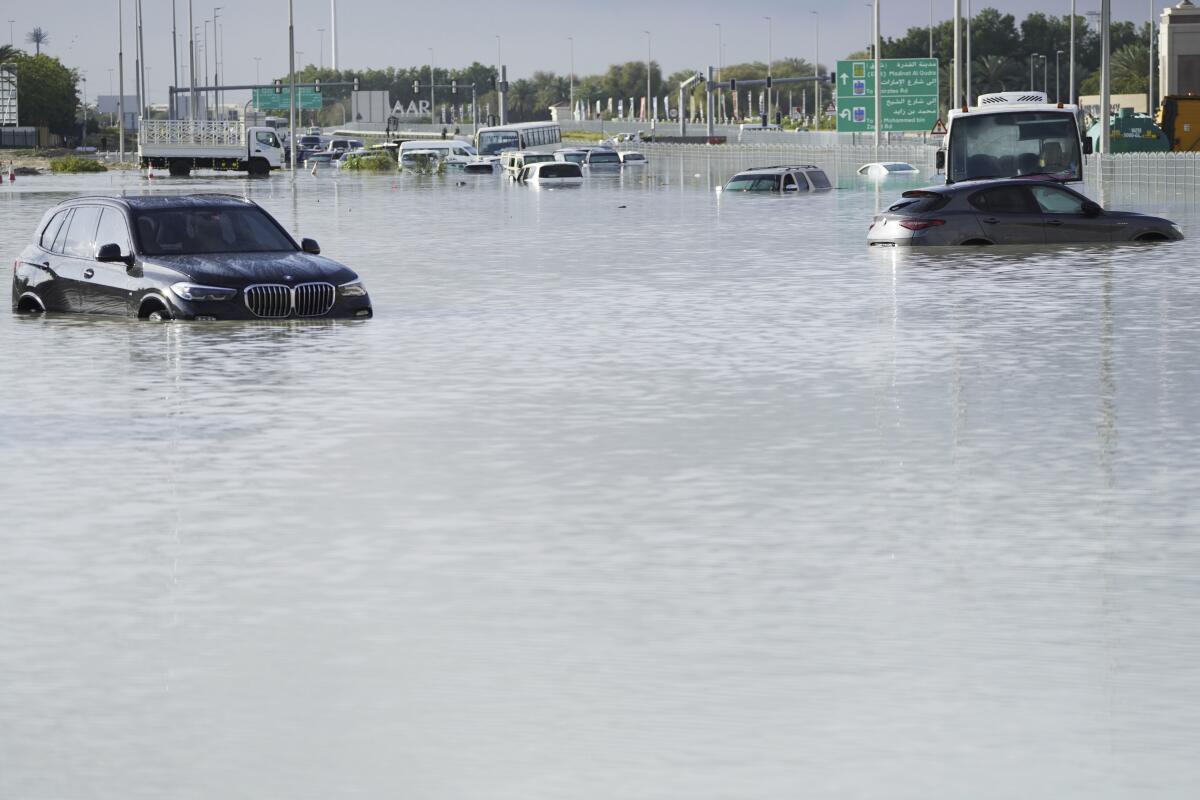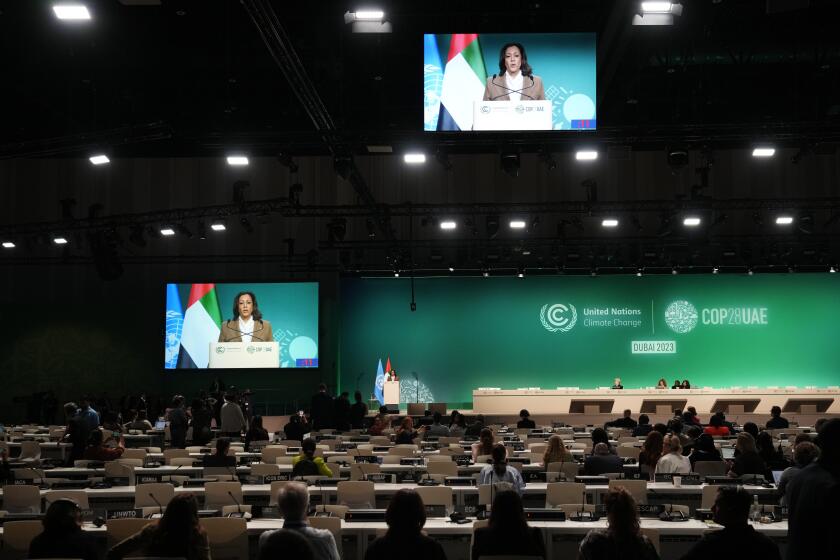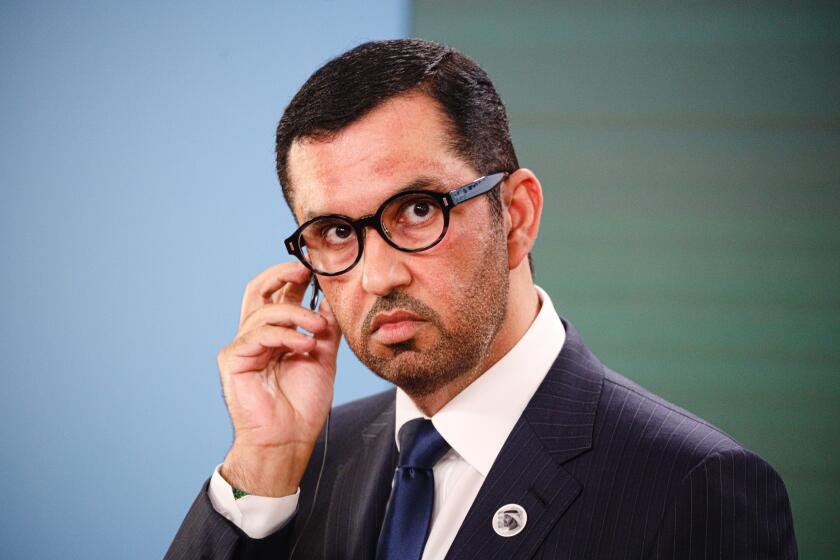Storm pounds desert nation of United Arab Emirates, floods Dubai airport

- Share via
DUBAI — The desert nation of the United Arab Emirates attempted to dry out Wednesday from the heaviest rain ever recorded there after a deluge flooded Dubai International Airport, disrupting flights through the world’s busiest airfield for international travel.
The state-run WAM news agency called the rain Tuesday “a historic weather event” that surpassed “anything documented since the start of data collection in 1949.” That’s before the discovery of crude oil in this energy-rich nation, which was then part of a British protectorate known as the Trucial States.
Rain also fell in Bahrain, Oman, Qatar and Saudi Arabia. However, the rains were acute across the UAE.
The flooding sparked speculation that cloud seeding — flying small planes through clouds dispersing chemicals aimed at getting rain to fall — may have caused the deluge. But experts said the storm systems that produced the rain were forecast well in advance and that cloud seeding would not have caused such flooding.
Several reports quoted meteorologists at the National Center for Meteorology as saying they flew six or seven cloud-seeding flights before the rains. Flight-tracking data analyzed by the Associated Press showed one aircraft affiliated with the UAE’s cloud-seeding efforts flew around the country Monday.
The National, an English-language, state-linked newspaper in Abu Dhabi, quoted an anonymous official at the center on Wednesday as saying no cloud seeding took place on Tuesday, without acknowledging any earlier flights.
Vice President Kamala Harris flew to the Middle East to tackle climate change and the Israeli-Palestinian conflict, challenges that have flummoxed White Houses for decades.
The center did not respond to questions Wednesday from the AP.
The UAE, which heavily relies on energy-hungry desalination plants to provide water, conducts cloud seeding in part to increase its dwindling, limited groundwater.
Jeff Masters, a meteorologist for Yale Climate Connections, said the flooding in Dubai was caused by an unusually strong low-pressure system that drove many rounds of heavy thunderstorms.
“You don’t need cloud seeding’s influence to account for the record deluge in Dubai,” Masters said.
Scientists also say climate change in general is responsible for more intense and more frequent extreme storms, droughts, floods and wildfires around the world. Dubai hosted the United Nations’ COP28 climate talks just last year. Rising temperatures and other effects of global warming long have been viewed as a threat to life in the already-baking region.
The rains began late Monday, soaking the sands and roadways of Dubai with some 0.79 inches of rain, according to meteorological data collected at Dubai International Airport. The storms intensified around 9 a.m. Tuesday and continued throughout the day, dumping more rain and hail onto the overwhelmed city.
By the end of Tuesday, more than 5.59 inches of rainfall had soaked Dubai over 24 hours. An average year sees 3.73 inches of rain at Dubai International Airport, a hub for the long-haul carrier Emirates.
Editorial: An oil executive’s going to host the U.N. climate summit. It shows who’s really in charge
Climate activists and politicians have likened the decision to letting arms dealers lead peace talks or putting a tobacco CEO in charge of health policy.
At the airport, standing water lapped on taxiways as aircraft landed. Arrivals were halted Tuesday night, and passengers struggled to reach terminals through the floodwaters covering surrounding roads.
One couple, who spoke to the AP on condition of anonymity to speak freely in a country with strict laws that criminalize critical speech, called the situation at the airport “absolute carnage.”
“You cannot get a taxi. There’s people sleeping in the Metro station. There’s people sleeping in the airport,” the man said Wednesday.
They ended up getting a taxi to drop them off near their home some 18 miles away, but floodwaters on the road slowed them down. A bystander helped them over a highway barrier with their carry-on luggage, the bottles of gin they picked up from duty-free shopping clinking away.
Dubai International Airport acknowledged Wednesday morning that the flooding had left “limited transportation options” and affected flights as aircraft crews couldn’t reach the airfield.
“Recovery will take some time,” the airport said on the social media platform X.
Nestled in the sand dunes an hour’s drive from the skyscrapers of Dubai, a desert village abandoned in the 1990s stands as an eerie relic.
Emirates said the airline had halted check-in for passengers departing from Dubai from 8 a.m. until midnight Wednesday as it tried to clear the airport of transit passengers — many of whom had been sleeping where they could in its cavernous terminals.
Passengers on FlyDubai, Emirates’ low-cost sister airline, also faced disruptions.
Paul Griffiths, the airport’s chief executive, acknowledged continued issues with flooding Wednesday morning, saying every place an aircraft could be safely parked was taken. Some aircraft had been diverted to Al Maktoum International Airport at Dubai World Central, the city-state’s second airfield.
“It remains an incredibly challenging time. In living memory, I don’t think anyone has ever seen conditions like it,” Griffiths told the state-owned talk radio station Dubai Eye. “We are in uncharted territory, but I can assure everyone we are working as hard as we possibly can to make sure our customers and staff are looked after.”
Egypt’s national carrier, EgyptAir, also temporarily suspended flights between Cairo and Dubai due to the bad weather.
Schools across the UAE, a federation of seven sheikhdoms, largely shut ahead of the storm and government employees were largely working remotely. Many other workers stayed home as well, though some ventured out, with the unfortunate stalling out their vehicles in deeper-than-expected water covering spots on some roads. That included parts of the Sheikh Zayed Road, a 12-lane highway through downtown Dubai.
The climate negotiations that just finished in Dubai hit on the essence of compromise, finding common language everyone accepted, at times grudgingly.
Authorities sent tanker trucks out into the streets and highways to pump away the water. Water poured into some homes, forcing people to bail out their houses.
The country’s hereditary rulers offered no overall damage or injury information for the nation, as some people slept in their flooded vehicles Tuesday night. In Ras al-Khaimah, the country’s northernmost emirate, police said one 70-year-old man died when his vehicle was swept away by floodwaters.
Khatm al-Shakla, an area near Al Ain in Abu Dhabi, saw 10 inches of rain Tuesday, the most anywhere in the country, officials said.
Authorities canceled school and the government instituted remote work again for Wednesday. Dubai later closed schools for the rest of the week.
Rain is unusual in the UAE, an arid, Arabian Peninsula nation, but occurs periodically during the cooler winter months. Many roads and other areas lack drainage given the lack of regular rainfall, causing flooding.
Meanwhile, in neighboring Oman, a sultanate that rests on the eastern edge of the Arabian Peninsula, at least 19 people were killed in heavy rains in recent days, according to a statement Wednesday from the country’s National Committee for Emergency Management. That includes some 10 schoolchildren swept away in a vehicle with an adult, prompting condolences into the country from rulers across the region.
Gambrell writes for the Associated Press. AP writer Samy Magdy in Cairo contributed to this report.
More to Read
Sign up for Essential California
The most important California stories and recommendations in your inbox every morning.
You may occasionally receive promotional content from the Los Angeles Times.













